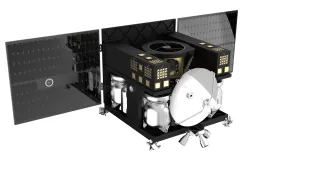
A device for controlling a computer with brain activity will be tested on the International Space Station. Scientists will check how microgravity affects blood flow in the brains of astronauts and human-machine communication.
'PhotonGrav' will be one of the 13 experiments in the Polish technological and scientific mission IGNIS to the International Space Station (ISS). It will be conducted by Sławosz Uznański-Wiśniewski, a Polish European Space Agency (ESA) project astronaut. The Ax-4 mission is scheduled to be launched on May 29.
Accodring to Dariusz Zapała, the 'PhotonGrav' project manager and scientific director at Cortivision, his company manufactures portable devices for recording brain activity for research purposes. 'Our devices are primarily used to conduct research in non-laboratory conditions. We test this equipment in many extreme conditions', explains the psychologist, who has professionally worked on brain-computer communication, among other things.
The device has already been used to record the work of astronauts' brains during the Ax-2 mission in 2023 and Ax-3 in 2024. 'When the opportunity arose to propose our own experiments for the Polish IGNIS mission, we decided to propose research on the possibility of using this technology in space conditions for communication. We will check how non-muscular application control works in microgravity conditions', Zapała says.
He explains that the device records the astronaut's brain activity, and machine learning algorithms - i.e. artificial intelligence - recognize different patterns of brain activity. These patterns can be assigned to different states - increased mental load and relaxation. The subject achieves increased brain activity by mentally multiplying double-digit numbers, and a state of rest - by avoiding intense thoughts.
'AI tries to automatically recognize whether the astronaut is relaxed or their mind is burdened by performing some activity. This allows to control the computer application', the scientist explains.
He clarifies that the equipment records the blood supply to individual areas of the brain and their oxygen demand - and the more intensively a part of the brain works, the greater this demand is. The device resembles an EEG, or electroencephalograph. Emitters placed on the head of the tested person send infrared light towards the brain, and detectors receive this light when it returns to the surface of the head.
'When light passes through individual layers of skin, bones, and finally brain tissue, the blood flowing through the brain partially scatters this light. As a result, only part of it returns to the surface of the head, where the detectors are located. Knowing the properties of the light sent towards the brain and the results recorded by the detectors, we can say whether a given area of the brain uses more or less oxygen', the project manager describes.
He adds that the information reaches an amplifier on the subject's forearm, and the amplifier sends the processed signal to a computer application via Bluetooth. During the experiment, the astronaut learns to control the application installed on the computer: the goal is to move the strip on the screen in a certain direction using only the brain.
The tests on members of the Ax-4 crew, including Sławosz Uznański-Wiśniewski, will be performed three times: before the flight (some of them have already been carried out), during their stay in orbit and after their return. The authors of the experiment will check how the results of working with the equipment differ in conditions on Earth and in space.
According to the psychologist, in the future, the solution developed by his team may be useful in space and on Earth: 'It can be used in extreme situations, when there is no medical personnel nearby, movements are difficult or when monitoring brain activity is important for safety reasons. These may be orbital stations or spaceships, and on Earth - isolated mountain trails, Arctic bases or drilling platforms, i.e. all places where other devices cannot be used to record brain activity. Our device may also be useful in cases where the health condition does not allow full muscle control - for example during recovery after injuries'.
He adds that conducting tests in space is so important because blood flow can change in microgravity conditions, which can interfere with the signal received by the device.
'Only in orbit can we examine how the human body and equipment behave in microgravity over a longer period of time. On Earth, weightlessness can be achieved for a maximum of several dozen seconds', Dariusz Zapała concludes.
The Ax-4 crew members are Peggy Whitson (USA) - commander; Sławosz Uznański-Wiśniewski (Poland/ESA) - specialist; Shubhanshu Shukla (India) - pilot and Tibor Kapu (Hungary) - specialist. The astronauts will spend 14 days on the International Space Station.
The Ax-4 mission will be a commercial crewed expedition carried out by Axiom Space. The Pole's participation in this mission is the result of an agreement signed between the Ministry of Development and Technology and the European Space Agency (ESA) to prepare and conduct the Polish scientific and technological mission IGNIS. The Polish Space Agency (POLSA) is also involved in the preparations as the executive agency of the Ministry of Development and Technology.
Sławosz Uznański-Wiśniewski will be the second Pole in space.PAP - Science in Poland, Anna Bugajska (PAP)
abu/ bar/ mhr/













